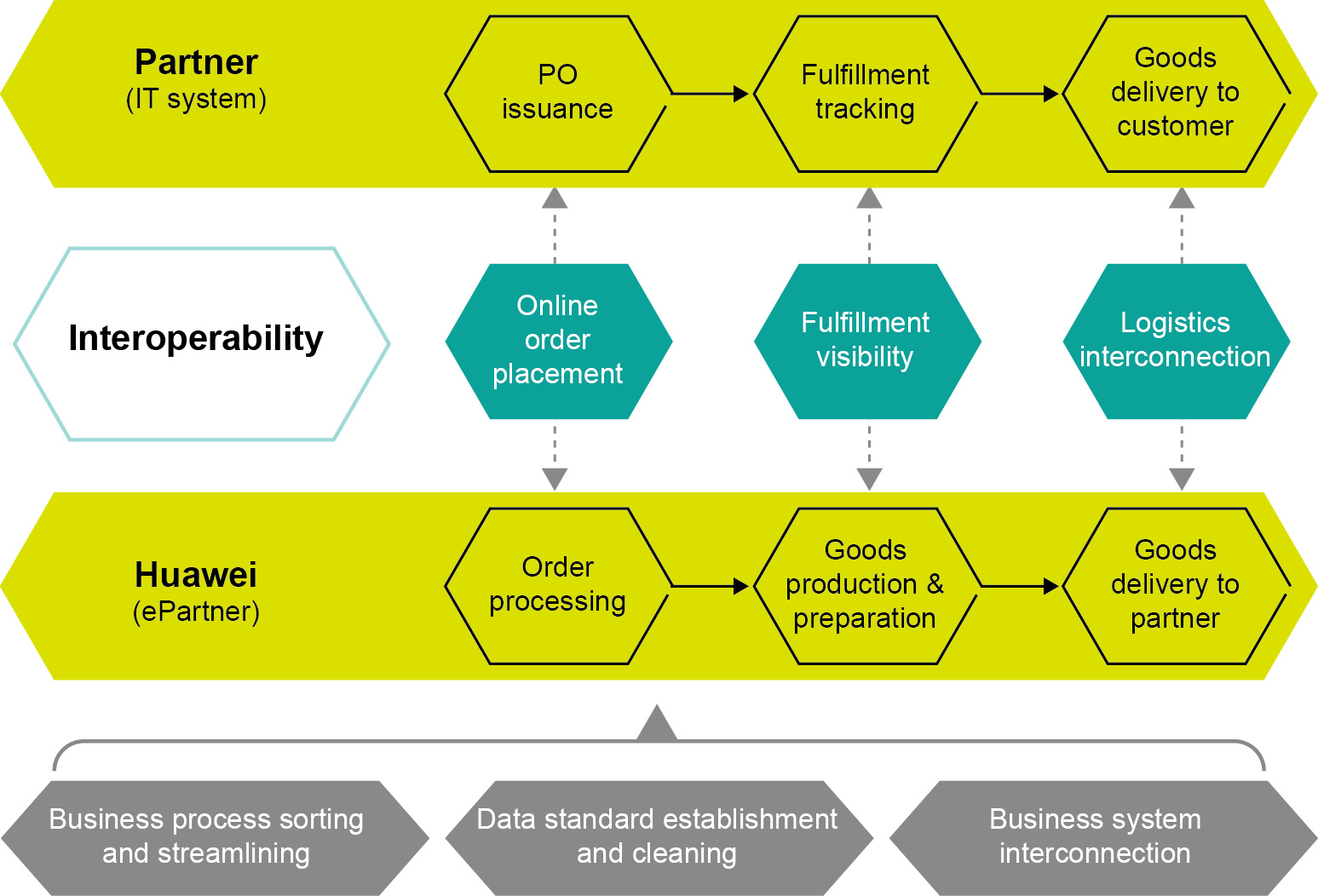Digital Ecosystems Enable Supply Information Sharing and Alignment Among Partners
Enterprise products, solutions & services

Huawei Enterprise Business Group (EBG) has experienced rapid business growth in recent years. To maintain its growth, Huawei EBG — in collaboration with partners — increased its efforts to build a digital channel ecosystem for the future. With that goal in mind, it released a policy in 2018 that encouraged distributors to organize the collection of goods themselves, rather than rely on inefficient delivery services. Huawei hoped that this move would improve the logistics capabilities of distributors and deliver a better warehouse service experience.
By 2019, distributors had adopted this ‘self-pickup’ mode in more than 80 percent of orders. However, another challenge emerged as logistics service volume surged: Tier-2 resellers and customers requested better logistics service quality. To achieve this, distributors began looking into how to improve their warehouse management efficiency.
Alongside its supply and value chain distributors, Huawei also faced challenges such as improving supply efficiency and perception while maintaining business growth.
In fact, these challenges caused problems for Huawei’s customers, who expressed their dissatisfaction with logistics systems that couldn’t be visually displayed. Comments included:
Huawei’s customers and Tier-2 resellers had grown accustomed to Huawei’s observable supply information display, providing real-time information about goods production, outbound status, and shipment. Naturally, they were unsatisfied that distributor logistics information wasn’t similarly displayed.
However, Huawei’s customers and Tier-2 resellers said that they were satisfied with Huawei’s own customer-centric supply value chain. The company’s supply managers had visited key distributors on multiple occasions, and they clearly understood that simple packing list information transfer was essential to support distributors’ logistics and warehouse management. They also understood that it had become harder for traditional information processing methods to satisfy modern business requirements. The distributors that continued to use traditional methods focused on improving labor management and efficiency, and they also identified several business challenges:
In 2019, to address these business development challenges, Huawei and its distributors began supply information sharing and alignment based on digital collaboration. Huawei developed an interconnection model for the channel supply collaboration system, which was used to streamline business processes, and establish unified data standards. It finally resulted in visible collaboration mechanisms that interconnected Huawei’s supply chain with the packing list and logistics systems of partners.
In May 2019, during the China Partner Supply Forum’s executive exchange, Huawei shared and aligned its digital collaboration strategy with distributors. Following the exchange, distributors increased their investment in digital system collaboration and interconnection, to carry out joint digital supply information interconnection with Huawei.
Huawei and distributors held at least two meetings every week to analyze distributors’ business processes and requirements, discuss feasible system interconnection solutions, and align business and IT solutions. All parties agreed for Huawei to transfer distributors’ key packing list information and distributor transfer logistics information, with data interconnection to be completed in 2019.
To establish logistics information interconnection security control, signature requests were used to protect back-end services and data transmission during Application Programming Interface (API) opening. Meanwhile, Huawei Customer Network Cooperation (CNC) served as the packing list information bridge, interconnecting partner systems with Huawei’s internal systems. By sharing and aligning information according to industry standards and regulations, Huawei enabled the “order placement by distributors and goods delivery to Tier-2 resellers/end customers” process while ensuring end-to-end logistics information visibility. The online transaction experience and supply efficiency for partners improved significantly.
Huawei continued to optimize user experiences following the success of the IT system interconnection, by making solutions more comprehensive and improving Time To Market (TTM) deliverables.
Huawei continued modifying the interconnection solution, supplementing key information to be aligned based on complicated packing list information and close collaboration of both parties’ business and IT systems, in order to improve the completeness and timeliness of data.
By analyzing interconnected information, systems can identify one-off delivery and multiple delivery scenarios. The logistics information of each individual journey during multiple deliveries is visible and searchable by using channel orders. This helps improve delivery service quality for end customers. Meanwhile, Huawei established an analysis platform for logistics information of distributors, to help improve delivery information flow and the implementation capabilities (physical goods delivery) of distributors.
Since August 2019, six distributors — VSTECS, Digital China, Kinghighway, Founder Century, Synnex, and CNBM — have collaborated with Huawei to implement system interconnection and information visibility, making logistics information visible to more than 6,000 Tier-2 resellers. Information sharing and alignment enable real-time goods tracking and in-transit status updates, helping Tier-2 resellers and customers better prepare for goods reception and inbound planning, while also improving logistics experiences and efficiency.
By deploying big data analytics, the logistics service quality of distributors can be supervised and evaluated on visualized dashboards, and analysis capabilities help Huawei collaborate with partners to improve end-customer service quality, with clearer targets, and optimized logistics capabilities.
System interconnection and information visibility have improved monthly distributor delivery efficiency by an average of five percent, and the visibility and completeness of logistics node information has improved by over 20 percent on average.

Figure 1: Supply information sharing and alignment based on digital collaboration
By adopting system interconnection, partners can share real-time information, such as Huawei’s supply status and logistics. The end-to-end, visible transaction and fulfillment status improves partners’ transaction experience. Moreover, Huawei’s efforts in digital ecosystem construction have been recognized by customers and partners alike.
Customer A: “I’m very glad that we can view the real-time logistics status of some distributors on Huawei’s platform, which enables us to arrange personnel in advance for the reception of goods. In addition, we can more accurately make and adjust subsequent plans for installation and testing. We hope that Huawei can release a mobile version in the future so that we can view the information anytime and anywhere.”
Customer B: “We have been querying the goods preparation information recently. Now, we can see the logistics information after the ‘distributor self-pickup’ node. This function is of great value to us. For example, when some orders are transferred to Shanghai, we can know the goods arrival information earlier than the distributor sales personnel. We don’t need to wait for the delayed logistics query results. We hope that all distributors can provide such information.”
Channel Partner A: “The system has been basically interconnected. Huawei’s packing list information can be transparently transferred in real-time and directly sent to our system. This reduces manual operations and improves efficiency. We hope that some minor issues can be further improved.”
Channel Partner B: “After the packing list information was interconnected, our operation efficiency greatly improved. We hope that we can further integrate more information, including order and invoice information, to improve overall operations efficiency.”